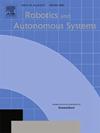Fall analysis and prediction for humanoids
IF 4.3
2区 计算机科学
Q1 AUTOMATION & CONTROL SYSTEMS
引用次数: 0
Abstract
In bipedal locomotion, avoiding falls is a significant and challenging issue, and addressing this challenge requires precise fall prediction methods. Since humanoid robots’ state data is a temporal signal in a high-dimensional feature space, how to extract appropriate features and enable rapid real-time response in actual systems constitutes a significant challenge. We designed an algorithm of convex hull vertexes selection (CHVS) for fall analysis, selecting features that contribute more to assessing the robot’s state. For the fall prediction, we first used an 11-dimensional statistical measure for feature extraction from the temporal signal. After state classification, we further incorporated the temporal accumulation effect, achieving a trade-off between minimizing false positive rates and maximizing advance prediction time. Subsequently, we designed a simple adjustment strategy for imminent falls and integrated it into the overall control framework. We validated the proposed fall prediction algorithm using the data of robot Q1. The validation was carried out under the condition of small sample training. We compared our algorithm with mainstream learning-based fall state classification methods, such as Long Short Term Memory Networks (LSTM) and Convolutional Neural Networks (CNN). The results show that the accuracy of state classification has increased by 3%–5%. At the same time, the computation time has been reduced by more than half. After time accumulation, the algorithm could predict more than 1 s in advance with a false positive rate of 0. The control framework incorporating the fall adjustment was tested in the simulation of the Cassie robot with an upper body. Some disturbances that could not be overcome under the original framework were adjusted to a normal motion state, proving the usefulness and feasibility of the proposed fall prediction for real-time dynamic scenarios to prevent falls.
求助全文
约1分钟内获得全文
求助全文
来源期刊

Robotics and Autonomous Systems
工程技术-机器人学
CiteScore
9.00
自引率
7.00%
发文量
164
审稿时长
4.5 months
期刊介绍:
Robotics and Autonomous Systems will carry articles describing fundamental developments in the field of robotics, with special emphasis on autonomous systems. An important goal of this journal is to extend the state of the art in both symbolic and sensory based robot control and learning in the context of autonomous systems.
Robotics and Autonomous Systems will carry articles on the theoretical, computational and experimental aspects of autonomous systems, or modules of such systems.
 求助内容:
求助内容: 应助结果提醒方式:
应助结果提醒方式:


